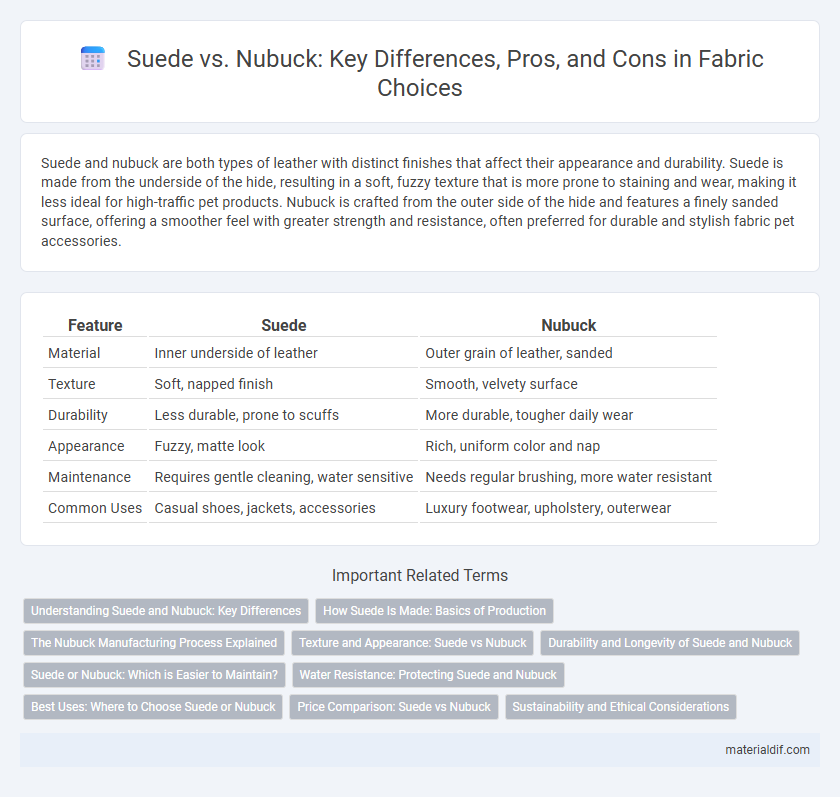Suede and nubuck are both types of leather with distinct finishes that affect their appearance and durability. Suede is made from the underside of the hide, resulting in a soft, fuzzy texture that is more prone to staining and wear, making it less ideal for high-traffic pet products. Nubuck is crafted from the outer side of the hide and features a finely sanded surface, offering a smoother feel with greater strength and resistance, often preferred for durable and stylish fabric pet accessories.
Table of Comparison
| Feature | Suede | Nubuck |
|---|---|---|
| Material | Inner underside of leather | Outer grain of leather, sanded |
| Texture | Soft, napped finish | Smooth, velvety surface |
| Durability | Less durable, prone to scuffs | More durable, tougher daily wear |
| Appearance | Fuzzy, matte look | Rich, uniform color and nap |
| Maintenance | Requires gentle cleaning, water sensitive | Needs regular brushing, more water resistant |
| Common Uses | Casual shoes, jackets, accessories | Luxury footwear, upholstery, outerwear |
Understanding Suede and Nubuck: Key Differences
Suede and Nubuck are both types of leather distinguished by their finishing processes; suede is made from the underside of the animal hide, resulting in a soft, napped texture, while Nubuck is crafted from the outer side and sanded to create a fine, velvety surface. Nubuck tends to be more durable and resistant to wear compared to suede, but both require special care to maintain their appearance due to their porous nature. Understanding these textural and durability differences is crucial for selecting the right fabric for fashion, upholstery, or accessories.
How Suede Is Made: Basics of Production
Suede is produced by sanding the inner surface of animal hides, typically from lamb, goat, or calf, creating a soft, napped finish. This production process differentiates suede from nubuck, which is made by sanding the outer grain of the hide, resulting in a finer texture. The specific sanding technique used in suede manufacturing enhances its pliability and distinctive velvety feel.
The Nubuck Manufacturing Process Explained
Nubuck fabric undergoes a unique manufacturing process involving the sanding or buffing of the outer layer of full-grain leather, creating a soft, velvety texture with a fine nap. Unlike suede, which is made from the inner split of leather, nubuck retains the durability and strength of the original hide, making it more resistant to wear and tear. The precise abrasion technique used in nubuck production ensures a luxurious finish prized in high-quality footwear and upholstery.
Texture and Appearance: Suede vs Nubuck
Suede features a soft, napped texture with a velvety feel created by buffing the underside of the animal hide, resulting in a matte finish that absorbs light evenly. Nubuck, crafted from the outer layer of the hide, exhibits a finer, more robust texture with a subtle sheen and slightly rougher surface that enhances durability and appearance. Both fabrics offer distinct tactile qualities and visual depth, with suede providing a plush softness and nubuck delivering a polished yet rugged look.
Durability and Longevity of Suede and Nubuck
Suede and nubuck are both types of leather with distinct durability characteristics; suede, made from the underside of the hide, tends to be softer but less resistant to wear and moisture. Nubuck, crafted from the outer side of the hide and sanded to create a velvety surface, offers greater durability and longevity due to its thicker grain. Proper care can extend the life of both materials, but nubuck's robustness makes it more suitable for everyday use and harsher conditions.
Suede or Nubuck: Which is Easier to Maintain?
Suede and nubuck differ in maintenance due to their texture and durability; suede, made from the inner split of the hide, generally resists stains better and requires less frequent cleaning compared to nubuck, which is sanded on the grain side and prone to showing water spots and dirt more easily. Nubuck demands careful handling with specialized brushes and cleaners to preserve its fine nap and avoid damage, while suede's thicker and fuzzier surface can often withstand more robust cleaning techniques. Choosing between suede and nubuck for ease of maintenance depends on the environment and frequency of use, with suede offering a more forgiving option for everyday wear.
Water Resistance: Protecting Suede and Nubuck
Suede and nubuck require careful water resistance strategies to maintain their durability and appearance. Applying a high-quality waterproof spray specifically designed for these fabrics creates an effective barrier against moisture and stains. Regular reapplication and prompt drying after exposure to water further preserve the texture and color of suede and nubuck materials.
Best Uses: Where to Choose Suede or Nubuck
Suede is best suited for fashion accessories, casual footwear, and soft upholstery due to its smooth texture and flexibility, offering a luxurious yet durable finish. Nubuck excels in rugged outdoor footwear, furniture, and automotive interiors because of its resilient surface and resistance to wear and stains. Choosing between suede and nubuck depends on the desired balance between softness and durability for specific applications.
Price Comparison: Suede vs Nubuck
Suede typically costs less than nubuck due to its simpler production process, which involves sanding the inner side of the animal hide. Nubuck, made from the outer side of the hide and requiring more intricate buffing to achieve its velvety texture, generally carries a higher price point. The price difference is often justified by nubuck's increased durability and refined appearance compared to suede.
Sustainability and Ethical Considerations
Suede and nubuck, both derived from leather, differ significantly in their sustainability impact due to production processes and material sourcing. Nubuck, made from the outer side of a hide, tends to be more durable and requires fewer chemical treatments, reducing its environmental footprint compared to suede, which is produced from the hide's underside and often involves more intensive processing. Ethical considerations emphasize sourcing from suppliers committed to humane animal treatment and environmentally responsible tanning methods, crucial for minimizing ecological harm in both suede and nubuck fabric production.
Suede vs Nubuck Infographic

 materialdif.com
materialdif.com